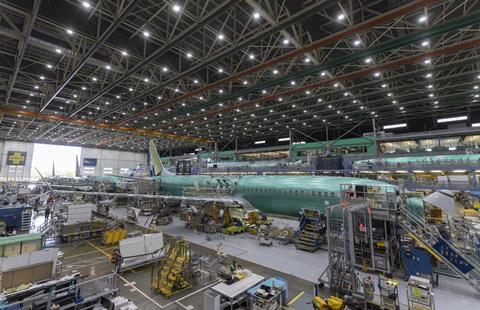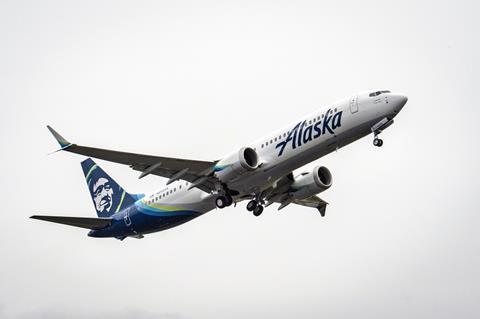Though the investigation into the 5 January fuselage failure of an Alaska Airlines Boeing 737 Max 9 is just getting underway, Boeing is already in the crosshairs.
Aerospace experts caution that the cause of the incident, which left a hole in the side of the Alaska jet, remains undetermined.
But they suspect the event, which involved a failed “plug” in an unused emergency exit door, likely resulted from a manufacturing or quality control problem at Boeing or one of its suppliers.

“The likely scenario is a manufacturing or inspection-related [issue] – a quality escape,” says AeroDynamic Advisory managing director Richard Aboulafia. “This comes down to something that happened at Boeing or Spirit.”
Spirit AeroSystems supplies 737 fuselages.
Former National Transportation Safety Board (NTSB) member John Goglia suspects the failed door plug was likely faulty when Boeing delivered the jet to Alaska, just more than two months ago.
“It would appear that Boeing needs to seriously increase the number of inspections of the installation of various pieces on their airplanes,” Goglia says.
The Alaska scare involved a 737 Max 9 operating flight 1282 from Portland to Ontario, California. Shortly after take-off, a “plug” filling one of jet’s mid-cabin emergency exits blew out, causing rapid depressurisation and leaving a massive hole in the 737’s side.
The pilots safely returned the jet to Portland. No passengers or crew suffered serious injuries, says the NTSB, which is investigating.
The Federal Aviation Administration already issued an emergency order requiring airlines ground Max 9s with door plugs, pending inspections.
Max 9s can carry up to 220 passengers, a configuration that requires airlines have an extra set of emergency exits, located mid-cabin, behind the wings.
But many airlines outfit 737 Max 9s with far fewer seats – Alaska’s have 178 seats. Those carriers often order the jets without mid-cabin exits. The exits are plugged and unusable, saving weight and eliminating the need for an extra flight attendant, says Goglia.
Sources say Spirit supplies the plugs with 737 fuselages, though neither the Wichita supplier nor Boeing have confirmed that detail.
Goglia says the plugs are simply emergency exit doors, but they lack handles for opening and closing. “It’s a real door” – not riveted shut but closed with a wrench and then concealed behind the cabin wall, he adds.
The plugs have proven safe and reliable over many years and millions of hours of flight service. The same plugs are found on the Max 9’s predecessor, the 737-900-series, experts note. Goglia says such plugs have been used for years on cargo jets without trouble.
“That’s a demonstrated technology,” says Michel Merluzeau, an aerospace analyst with AIR.
Experts can think of no reason why the plug on the Alaska jet would have been damaged or altered since the airline received the aircraft two months ago.
“Fundamentally, we go back to the production challenges that Boeing has been faced with, from a supplier standpoint,” says Merluzeau. “Also the workforce problems.”
Goglia suspects the Alaska’s jets failed plug might have suffered from a manufacturing problem, or perhaps been installed improperly.

Another possibility, he says: Boeing’s workers, at some point during final assembly, opened the plug – perhaps for fresh air or to bring materials into the cabin – and then failed to properly close it.
Boeing and its suppliers have faced significant workforce shortages and supply chain disruptions in recent years. The US manufacturing giant has been grating against such issues while relentlessly seeking to boost production.
Airbus and its suppliers have faced similar challenges, but Boeing has seemingly suffered more setbacks, as has Spirit.
The 737 programme has been beset with hiccups. Last week, news broke that Boeing was urging carriers to inspect 737 Max jets for loose bolts in rudder assemblies. In August, Spirit revealed it had delivered many 737 Max fuselages with potentially defective aft-pressure bulkheads. That issue requires Boeing complete arduous inspections of more than 150 undelivered 737s and forced it to walk back delivery goals.
Some sources have attributed the quality problems partly to errors resulted from less-skilled workers. Boeing hired many new workers recently to replace talented employees lost both to the pandemic and to ongoing retirements.
Issues aside, the company is still working to boost 737 production. It reached a rate of 31 jets monthly last year and aims to hit 50 monthly by 2025 or 2026.
“You cannot do [that] without increased automation and better quality control,” says Merluzeau.
Goglia wonders if the FAA should even allow more rate hikes.
“If I were the FAA , I’d say, ‘Show me when you can produce six months of airplanes with minimal quality problems, and then we will talk about it,’” he says.


























